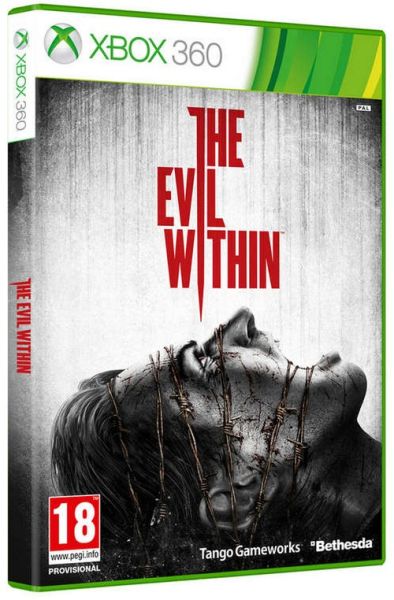The Evil Within Xbox One
The Evil Within follows the character of Sebastian Castellanos, a police detective working in a crime-filled metropolis called Krimson City. When Castellanos and his partners are summoned to the scene of a bloody mass murder, they find themselves separated and teleported into a twisted version of reality where regular humans are turned into horrifying, mutated killers.
While the setup allows for a more psychological bent than many modern survival horror games, I can't say that the plot of The Evil Within ever really pulled me in. Much of the blame for that rests on the shoulders of the dull leading man and thin supporting cast.
Sebastian is the generic, gruff, seen-some-shit, haunted-by-his-past horror protagonist, through and through. I made educated guesses about his backstory 20 minutes into the game; they were all spot on, one by one revealed as "twists" hours down the road. That's not bragging, either. I'm no great narrative psychic — the plot and especially the characterization are just that predictable.

Sebastian's partner Joseph and rookie-in-training Kidman have a little more depth but are so underutilized that it's hard to catch it. The Evil Within has an unending passion for reuniting Sebastian with his colleagues for half a chapter or so only to rip them apart again without warning. Kidman will be starring in two already-announced DLC packs for the game. Perhaps those will end up being the ideal Evil Within experience.
The lack of ceremony behind Kidman and Joseph's comings and goings hints at a bigger problem with pacing throughout The Evil Within. The game is split into chapters, but there's no real arc to these segments. Boss fights are peppered throughout, sometimes at the end, sometimes in the middle, sometimes multiple bosses per chapter, thrown at the player like a gauntlet. There's no discernible rhyme or reason, no build to a climax, just seemingly random jumps back and forth between silent exploration and violent conflict.
Occasionally chapters ended on a fitting cliffhanger, which made me eager to continue on to the next scene immediately. More often, they ended upon opening a random door or climbing a random ladder, entering another dim room or hallway that was in no way special. There's plenty of tension in The Evil Within, but it shows no capacity for regulating that tension.

This problem extends to combat as well. While The Evil Within is ostensibly a horror game, it is first and foremost a third-person shooter. And at its best, that shooting feels great. The game provides a limited arsenal — a pistol, a shotgun and a crossbow will be your primary weapons for the first half, with a few other options becoming available later on. Each of these weapons is useful in different situations, and the extreme scarcity of ammo in the game requires playing smart with them, which makes each successful kill hugely satisfying.
But The Evil Within often provides almost no breathing room between intense, exhausting encounters. No sooner would I clear a room of a half dozen enemies than another half dozen would appear to take their place, with a frustrated quip from the protagonist. Stealth and running away are options for a portion of the scenarios, but just as many force you to take out all of the enemies before moving on.

Even in the rare instances where the encounter design gels, I found myself frustrated by some of The Evil Within's choices. Boss encounters, in particular, are incredibly frequent and incredibly annoying. With few exceptions, these bigger enemies require very specific, obscure steps to be defeated or a stupidly large amount of ammunition — or both. Most of these bosses also launch into one-hit kill animations if they get in close, but even those that don't can usually drain Sebastian from full health to dead in two or three hits.
Every boss encounter shifted into a similar pattern for me: Start the fight, die, piece together the first thing I'm supposed to do to win, die again, piece together the second and third steps, die again and so on, until I figured out each part of the fight and was able to string them all together without a mistake.
Add in just-long-enough-to-be-bothersome loading times, and these boss encounters became a dull trial-and-error experience that drained a lot of the suspense from the game. Boss encounters also often drained my ammo, which can be a real killer. I can't count the number of times I was relieved to see an ammo pack shimmering on the ground only to pick it up and receive a measly one bullet.
While the distress surrounding my lack of ammo only worked to better the game intermittently, the horror present in The Evil Within's atmosphere and incredible environments was much more consistently successful. Without spoiling anything in the story, The Evil Within has a hook that allows for Sebastian to be swiftly and frequently transported between varied, warped environments.

The Evil Within is at its spookiest in these quieter segments
From one hour to the next, I found myself jumping from a cottage-pocked countryside to a creepy catacomb to a well-lit, high-tech medical facility, and everything in between. For a while I viewed those sudden shifts in environment as a problem, something tied to the lack of build in the arc of each chapter. After all, I moved between areas so quickly that it was hard for The Evil Within to create a greater sense of "place" within Krimson City. It ends up working to the game's benefit, though, and is more than accounted for in the narrative.
My favorite parts of The Evil Within were exploring these environments, watching them morph around me, avoiding traps and searching for secrets within them. Things were at their spookiest and most satisfying in these quieter segments with limited enemy numbers. The game also encourages and rewards thorough explorers with more of that ever-rare ammo, plus green goo that the main character uses to progress in the game's well-developed skill upgrade system.
That upgrade system is one of the few things that kept me happy throughout The Evil Within. In addition to buffing basic character stats, such as total health and melee damage, each individual weapon can be upgraded in numerous categories. Each upgrade felt like a notable improvement, and there were far more than I could grab in one playthrough. There's a new-game-plus option that allows you to carry your upgrades over to future playthroughs as well; I suspect the general enjoyability of the game will be improved by being overpowered in those runs.
| Brand | Xbox |
|---|---|
| Warranty | Check at Delivery |
| Shipping | Same Day From Lahore |










Log In